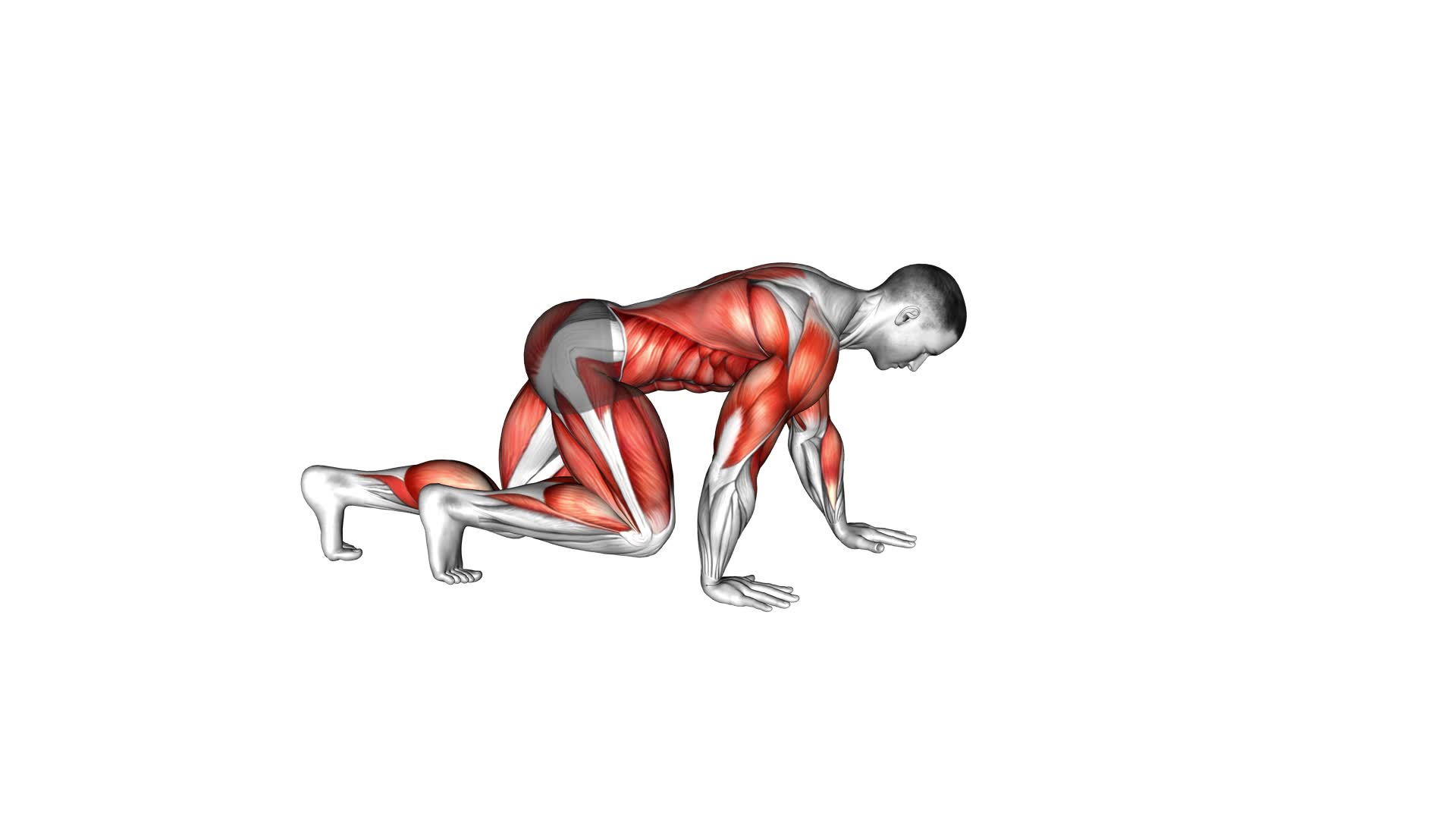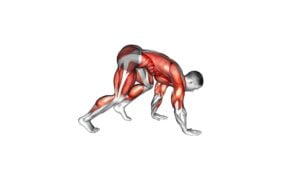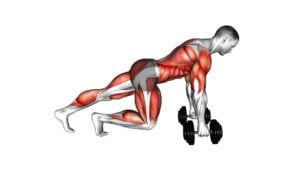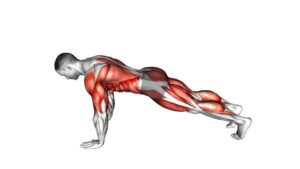Bear Crawl (Low Hip) (Male) – Video Exercise Guide & Tips

Get ready to level up your workout with the Bear Crawl (Low Hip) (Male) exercise!
Watch This Exercise Video
This video exercise guide & tips will show you the proper form and technique to maximize your gains.
Avoid common mistakes and learn variations and progressions to challenge yourself.
We've got expert tips to help you make the most out of this intense workout.
So grab your mat, press play, and get ready to bear crawl your way to a stronger you!
Key Takeaways
- Bear Crawl (Low Hip) (Male) targets multiple muscle groups, including core, arms, shoulders, and legs.
- Maintaining proper form and technique is crucial for maximizing the benefits of the exercise and preventing injuries.
- Common mistakes to avoid during Bear Crawl (Low Hip) (Male) include lifting hips too high, rounding the back, and rushing through the exercise.
- Variations and progressions for Bear Crawl (Low Hip) (Male) include modified bear crawl, adding weights, spiderman crawl, and bear crawl with knee tap.
Benefits of Bear Crawl (Low Hip) (Male)
Discover the numerous benefits you can achieve by incorporating the Bear Crawl (Low Hip) (Male) exercise into your fitness routine.
The Bear Crawl (Low Hip) is a highly effective exercise that targets multiple muscle groups, making it a great addition to any workout regimen. This exercise primarily works your core muscles, including the abs, obliques, and lower back. By engaging these muscles, the Bear Crawl (Low Hip) helps to improve your overall stability and balance.
In addition to the core, this exercise also engages the muscles in your arms, shoulders, and legs. The crawling motion requires you to support your body weight on your hands and feet, which helps to strengthen your upper body and increase muscle endurance. It also activates your leg muscles, including the quads, hamstrings, and glutes, giving you a full-body workout.
Furthermore, the Bear Crawl (Low Hip) exercise is a great way to improve your cardiovascular fitness. The continuous movement of crawling helps to raise your heart rate and increase your endurance. It can be a challenging exercise, but with consistent practice, you'll see improvements in your overall fitness level.
Now that you know the benefits of the Bear Crawl (Low Hip) exercise, let's move on to discussing the proper form and technique for performing this exercise.
Proper Form and Technique for Bear Crawl (Low Hip) (Male)
To perform the Bear Crawl with proper form and technique, it's important to focus on your hip positioning during the crawl. Keep your hips low to the ground and parallel to the floor, maintaining a straight line from your head to your heels.
This position engages your core, stabilizes your body, and maximizes the benefits of the exercise.
Hip Positioning During Crawl
Maintaining proper hip positioning during the bear crawl exercise is crucial for optimal form and technique. This exercise requires both hip stability and mobility to be executed correctly. To ensure proper hip positioning, start by placing your hands directly under your shoulders and your knees under your hips. By keeping your hips low, you engage your core muscles to stabilize your body. It's important to avoid letting your hips sag or rise too high, as this can lead to improper form and potential injury. By maintaining the correct hip position, you effectively engage your glutes, quadriceps, and core muscles, maximizing the benefits of the bear crawl exercise.
Now, let's explore the benefits of maintaining proper form throughout this exercise.
Benefits of Proper Form
You should consistently strive to maintain proper form and technique during the bear crawl (low hip) exercise to maximize its benefits. By doing so, you can improve your strength and build core stability. Proper form ensures that you engage the correct muscles and distribute the workload evenly throughout your body.
This exercise targets multiple muscle groups, including your shoulders, arms, core, and legs. By maintaining a stable low hip position and keeping your back straight, you activate your core muscles and promote better stability. This not only enhances your overall strength but also helps to prevent injuries.
By focusing on proper form, you can make the most out of your bear crawl (low hip) exercise and achieve optimal results.
Now, let's move on to the next section and learn about common mistakes to avoid during bear crawl (low hip) (male).
Common Mistakes to Avoid During Bear Crawl (Low Hip) (Male)
During the Bear Crawl (Low Hip) (Male), it's important to be mindful of the common mistakes that can hinder your performance. Here are some tips for improvement:
- Lifting your hips too high: One common mistake is lifting your hips too high, which can put unnecessary strain on your shoulders and decrease the effectiveness of the exercise. To avoid this, focus on keeping your hips low and parallel to the ground throughout the movement.
- Rounding your back: Another mistake is rounding your back instead of maintaining a neutral spine. This can lead to lower back pain and decrease the effectiveness of the exercise. To fix this, engage your core muscles and imagine a straight line from your head to your tailbone.
- Losing stability and control: Many people tend to rush through the bear crawl, sacrificing stability and control. This can increase the risk of injury and diminish the benefits of the exercise. To improve, focus on maintaining a slow and controlled movement, keeping your core tight and your shoulders stable.
Variations and Progressions for Bear Crawl (Low Hip) (Male)
Now let's explore some variations and progressions to make your Bear Crawl (Low Hip) (Male) more challenging and effective.
One option is the Modified Bear Crawl, where you elevate your knees slightly off the ground to engage your core and upper body more intensely.
Another way to increase the difficulty is by adding weights to your hands or ankles, forcing your muscles to work harder.
Don't be afraid to push yourself and try these variations to take your Bear Crawl to the next level.
Modified Bear Crawl
To modify the Bear Crawl (Low Hip) exercise for variations and progressions, begin by incorporating different hand and foot placements. This will challenge your body in new ways and improve your overall hip mobility.
Here are some modified bear crawl variations to try:
- Spiderman Crawl: Instead of moving forward with both hands and feet, bring your knee to your elbow as you crawl. This variation targets your core and hip flexors.
- Bear Crawl with Knee Tap: As you crawl, tap your opposite knee to the ground with each step. This variation adds an extra stability challenge and works your hip abductors.
- Bear Crawl with Resistance Band: Attach a resistance band around your ankles and perform the bear crawl. This will engage your hip muscles even more and improve your hip strength.
Incorporating these modified bear crawl variations into your workouts will help you improve your hip mobility and take your fitness to the next level.
Increasing Crawl Difficulty
To increase the difficulty of the Bear Crawl (Low Hip) exercise, you can incorporate variations and progressions that challenge your body in new ways and further improve your hip mobility.
One way to increase the intensity is by performing the crawl on an incline or decline, such as crawling up or down a hill or using an inclined or declined surface. This will engage your muscles differently and make the exercise more challenging.
Another option is to add weight by wearing a weighted vest or attaching ankle weights. This will increase the resistance and make your muscles work harder.
Additionally, you can try performing the crawl with a single leg, alternating legs with each step. This requires greater stability and control, making it an advanced modification of the exercise.
Incorporating these variations and progressions will help you continue to challenge your body and make progress in your fitness journey.
Tips for Maximizing the Effectiveness of Bear Crawl (Low Hip) (Male)
How can you enhance the effectiveness of the Bear Crawl (Low Hip) (Male)? Here are some tips to maximize the effectiveness of this exercise and incorporate it into your full body workouts:
- Maintain proper form: Keep your hips low, your back straight, and your core engaged throughout the entire movement. This will help target your core muscles and improve your overall stability.
- Increase the intensity: To challenge yourself and maximize endurance, try increasing the speed of your bear crawl or adding resistance by wearing a weighted vest. This will increase the workload on your muscles and help improve your cardiovascular fitness.
- Vary your movements: Instead of just moving forward and backward, try crawling in different directions, such as sideways or diagonally. This will engage different muscle groups and help prevent boredom.
- Incorporate into full body workouts: The bear crawl is a versatile exercise that can be incorporated into a variety of full body workouts. You can use it as a warm-up or include it in a circuit training routine to target multiple muscle groups and improve overall strength and endurance.
Sample Bear Crawl (Low Hip) (Male) Workout Routine
To incorporate the Bear Crawl (Low Hip) (Male) into your workout routine, try following this sample workout plan.
The Bear Crawl is a versatile exercise that engages multiple muscle groups and can be modified to suit your fitness level.
Begin your workout with a dynamic warm-up to prepare your body for movement. This can include exercises like jumping jacks, high knees, and arm circles.
Next, perform the Bear Crawl as the main exercise in your workout. Start in a plank position with your hands under your shoulders and your knees hovering just above the ground. Engage your core and crawl forward, moving opposite hand and foot at the same time. Maintain a low hip position throughout the movement to maximize the challenge to your core and upper body.
Perform 3 sets of 10-12 reps, resting for 30 seconds between sets. As you become more comfortable with the exercise, you can increase the number of sets or reps.
To incorporate the Bear Crawl into a full body workout, you can add other exercises such as push-ups, squats, lunges, and planks. This combination will provide a comprehensive workout that targets your upper body, lower body, and core.
Remember to listen to your body and modify the exercises as needed to avoid injury.
Frequently Asked Questions
How Many Calories Can You Burn Doing Bear Crawl (Low Hip) (Male)?
When it comes to burning calories, the bear crawl (low hip) (male) is a great choice. This exercise engages multiple muscle groups and helps to increase your heart rate, leading to calorie burn.
The exact number of calories burned can vary based on factors like intensity, duration, and your body weight.
Can Bear Crawl (Low Hip) (Male) Help Improve Core Strength?
Bear crawl (low hip) (male) is an effective exercise for improving core strength. By engaging your abdominal muscles, it helps stabilize your body and improve overall fitness. This exercise can be modified to suit different fitness levels, whether you're a beginner or advanced.
Variations like bear crawl with knee taps or bear crawl with shoulder taps can add extra challenge.
Incorporating bear crawl (low hip) (male) into your workout routine can provide numerous benefits for your core strength and overall fitness.
Is Bear Crawl (Low Hip) (Male) Suitable for Beginners?
Yes, bear crawl (low hip) (male) is suitable for beginners. If you're new to this exercise, there are modifications you can make to make it easier. For example, you can start by keeping your knees on the ground instead of fully extending your legs.
Bear crawl (low hip) (male) is a great way to improve core strength and stability. By incorporating it into your beginner's workout routine, you'll see benefits like improved balance and overall body control.
Can Bear Crawl (Low Hip) (Male) Help With Weight Loss?
Bear crawl (low hip) (male) is a great exercise for weight loss. By incorporating this movement into your workout routine, you can burn calories, build strength, and improve cardiovascular endurance.
The benefits of bear crawl (low hip) include targeting multiple muscle groups such as the shoulders, core, and legs. Additionally, there are variations of bear crawl (low hip) that can challenge you even further, such as adding resistance or increasing speed.
What Muscles Does Bear Crawl (Low Hip) (Male) Target?
Bear crawl (low hip) (male) primarily targets your core muscles, including the abs, obliques, and lower back. It also engages your shoulders, chest, and triceps, making it a great exercise for upper body strength.
To perform the bear crawl with proper form, keep your hips low and your back flat, and make sure to engage your core throughout the movement.
Incorporating different bear crawl variations can further challenge your muscles and enhance your workout routine.
Conclusion
In conclusion, the bear crawl (low hip) exercise is a beneficial workout for males, targeting the core, arms, and legs. By maintaining proper form and technique, you can maximize the effectiveness of this exercise and avoid common mistakes.
Additionally, incorporating variations and progressions can help challenge your fitness level. Remember to focus on engaging your muscles and maintaining control throughout the movement.
Include the bear crawl (low hip) exercise in your workout routine for a full-body workout.

Author
Years ago, the spark of my life’s passion ignited in my mind the moment I stepped into the local gym for the first time. The inaugural bead of perspiration, the initial endeavor, the very first surge of endorphins, and a sense of pride that washed over me post-workout marked the beginning of my deep-seated interest in strength sports, fitness, and sports nutrition. This very curiosity blossomed rapidly into a profound fascination, propelling me to earn a Master’s degree in Physical Education from the Academy of Physical Education in Krakow, followed by a Sports Manager diploma from the Jagiellonian University. My journey of growth led me to gain more specialized qualifications, such as being a certified personal trainer with a focus on sports dietetics, a lifeguard, and an instructor for wellness and corrective gymnastics. Theoretical knowledge paired seamlessly with practical experience, reinforcing my belief that the transformation of individuals under my guidance was also a reflection of my personal growth. This belief holds true even today. Each day, I strive to push the boundaries and explore new realms. These realms gently elevate me to greater heights. The unique combination of passion for my field and the continuous quest for growth fuels my drive to break new ground.







